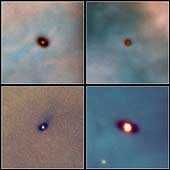|
COMETS EARTH JUPITER KUIPER BELT MARS MERCURY METEORITES NEPTUNE OORT CLOUD PLUTO SATURN SOLAR SYSTEM SPACE SUN URANUS VENUS ORDER PRINTS
PHOTO CATEGORIES SCIENCEVIEWS AMERICAN INDIAN AMPHIBIANS BIRDS BUGS FINE ART FOSSILS THE ISLANDS HISTORICAL PHOTOS MAMMALS OTHER PARKS PLANTS RELIGIOUS REPTILES SCIENCEVIEWS PRINTS
|
Related Documents
Download Options
These are Hubble Space Telescope images of four newly discovered protoplanetary disks around young stars in the Orion nebula, located 1,500 light-years away. Gas and dust disks, long suspected by astronomers to be an early stage of planetary formation, can be directly seen in visible light by Hubble. Disks around young stars (also known as circumstellar or protoplanetary disks) are thought to be made up of 99% gas and 1% dust. Even that small amount of dust is enough to make the disks opaque and dark at visible wavelengths. The dark disks are seen in these images because they are silhouetted against the bright backdrop of the hot gas of the Orion nebula. The red glow in the center of each disk is a young, newly formed star, roughly one million years old (compared to the 4.5 billion year age of the Sun). The stars range in mass from 30% to 150% of the mass of our own Sun. As they evolve, the disks may go on to form planetary systems like our own. While only a handful of these dark silhouette disks have been discovered so far, they seem to belong to a much larger family of similar objects, and current indications are that protoplanetary disks are common in the Orion nebula. Mark McCaughrean of the Max-Planck-Institute for Astronomy, Heidelberg, Germany, and his collaborator C. Robert O'Dell from Rice University, Houston, Texas, spotted the new disks in large-scale survey images of the Orion nebula that O'Dell had taken with Hubble between January 1994 and March 1995. A detailed study of the disk images has been submitted for publication to the Astronomical Journal. Each image is 167 billion miles, or 257 billion kilometers across (30 times the diameter of our own solar system). The disks range in size from two to eight times the diameter of our solar system. The researchers explain the different circular or elliptical shapes as being due to the fact that each disk is tilted toward Earth by different degrees. Each picture is a composite of three images taken with Hubble's Wide Field and Planetary Camera 2, through narrow-band filters which admit the light of emission lines of ionized oxygen (represented here by blue), hydrogen (green), and nitrogen (red). The hot gas of the background Orion nebula emits strongly at each of these wavelengths, providing a strong backdrop for the disks to be silhouetted against. In each case, the central star is also clearly visible. Credit: Mark McCaughrean (Max-Planck-Institute for Astronomy), C. Robert O'Dell (Rice University), and NASA |
